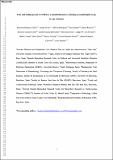Por favor, use este identificador para citar o enlazar a este item:
http://hdl.handle.net/10261/201538COMPARTIR / EXPORTAR:
 SHARE SHARE
 CORE
BASE CORE
BASE
|
|
| Visualizar otros formatos: MARC | Dublin Core | RDF | ORE | MODS | METS | DIDL | DATACITE | |

| Campo DC | Valor | Lengua/Idioma |
|---|---|---|
| dc.contributor.author | Rodríguez-Calvo, R. | - |
| dc.contributor.author | Girona, Josefa | - |
| dc.contributor.author | Rodríguez, Marina | - |
| dc.contributor.author | Samino-Gené, Sara | - |
| dc.contributor.author | Barroso, Emma | - |
| dc.contributor.author | Gonzalo-Calvo, David de | - |
| dc.contributor.author | Guaita-Esteruelas, Sandra | - |
| dc.contributor.author | Heras, Mercedes | - |
| dc.contributor.author | Meer, Rutger W. van der | - |
| dc.contributor.author | Lamb, Hildo J. | - |
| dc.contributor.author | Yanes, Óscar | - |
| dc.contributor.author | Correig, Xavier | - |
| dc.contributor.author | Llorente-Cortés, Vicenta | - |
| dc.contributor.author | Vázquez-Carrera, Manuel | - |
| dc.contributor.author | Masana, Lluis | - |
| dc.date.accessioned | 2020-02-21T11:56:04Z | - |
| dc.date.available | 2020-02-21T11:56:04Z | - |
| dc.date.issued | 2019-07 | - |
| dc.identifier | doi: 10.1016/j.metabol.2019.04.007 | - |
| dc.identifier | issn: 1532-8600 | - |
| dc.identifier | issn: 0026-0495 | - |
| dc.identifier.citation | Metabolism - Clinical and Experimental 96: 12-21 (2019) | - |
| dc.identifier.uri | http://hdl.handle.net/10261/201538 | - |
| dc.description.abstract | Objective: Fatty acid binding protein 4 (FABP4) is an intracellular lipid chaperone involved in the crosstalk between adipose and peripheral tissues, and it contributes to widespread insulin resistance in cells, including cardiac cells. However, the role of this adipokine in regulating cardiac metabolism and myocardial neutral lipid content in patients with type 2 diabetes has not been elucidated. Methods: The impact of circulating FABP4 on the cardiac neutral lipid content was measured by proton magnetic resonance spectroscopy (H-MRS) in patients with type 2 diabetes. Additionally, circulating FABP4 and the cardiac triglyceride content were analysed in high-fat diet (HFD)-fed mice, and the impact of the exogenous FABP4 was explored in HL-1 cardiac cells. Results: Serum FABP4 levels were higher in type 2 diabetic patients compared to healthy individuals. Circulating FABP4 levels were associated with myocardial neutral lipid content in type 2 diabetic patients. In HFD-fed mice, both serum FABP4 and myocardial triglyceride content were increased. In FABP4-challenged HL-1 cells, extracellular FABP4 increased intracellular lipid accumulation, which led to impairment of the insulin-signalling pathway and reduced insulin-stimulated glucose uptake. However, these effects were partially reversed by FABP4 inhibition with BMS309403, which attenuated the intracellular lipid content and improved insulin signalling and insulin-stimulated glucose uptake. Conclusions: Taken together, our results identify FABP4 as a molecule involved in diabetic/lipid-induced cardiomyopathy and indicate that this molecule may be an emerging biomarker for diabetic cardiomyopathy-related disturbances, such as myocardial neutral lipid accumulation. Additionally, FABP4 inhibition may be a potential therapeutic target for metabolic-related cardiac dysfunctions. | - |
| dc.description.sponsorship | This work was supported by funds from Instituto de Salud Carlos III (ISCIII), Madrid, Spain [PI15/00627 to LM and PI14/01729 to VLlC], Fondo Europeo de Desarrollo Regional [FEDER to LM], the CIBER in Diabetes and Associated Metabolic Disorders [CB07/08/0028 to LM and CB07/08/0003 to MV-C] and CIBER Cardiovascular [CB16/11/00403 to DdG-C and VL-C], the Spanish Ministerio de Economía y Competitividad [SAF2015-64146-R to MV-C and TEC2015-69076-P to XC] and Fundació la Marató de TV3 2014 [to MV-C]. DdG-C was a recipient of Sara Borrell grant from the Instituto de Salud Carlos III Grant [CD14/00109]. | - |
| dc.language | eng | - |
| dc.publisher | Elsevier BV | - |
| dc.relation | info:eu-repo/grantAgreement/MINECO/Plan Estatal de Investigación Científica y Técnica y de Innovación 2013-2016/SAF2015-64146-R | - |
| dc.relation | info:eu-repo/grantAgreement/MINECO/Plan Estatal de Investigación Científica y Técnica y de Innovación 2013-2016/TEC2015-69076-P | - |
| dc.relation.isversionof | Postprint | - |
| dc.rights | openAccess | en_EN |
| dc.title | Fatty acid binding protein 4 (FABP4) as a potential biomarker reflecting myocardial lipid storage in type 2 diabetes | - |
| dc.type | artículo | - |
| dc.identifier.doi | 10.1016/j.metabol.2019.04.007 | - |
| dc.relation.publisherversion | http://dx.doi.org/10.1016/j.metabol.2019.04.007 | - |
| dc.date.updated | 2020-02-21T11:56:05Z | - |
| dc.contributor.funder | Instituto de Salud Carlos III | - |
| dc.contributor.funder | European Commission | - |
| dc.contributor.funder | Centro de Investigación Biomédica en Red de Diabetes y Enfermedades Metabólicas Asociadas (España) | - |
| dc.contributor.funder | Centro de Investigación Biomédica en Red Enfermedades Cardiovaculares (España) | - |
| dc.contributor.funder | Ministerio de Economía y Competitividad (España) | - |
| dc.contributor.funder | Fundació La Marató de TV3 | - |
| dc.relation.csic | Sí | - |
| dc.identifier.funder | http://dx.doi.org/10.13039/100008666 | es_ES |
| dc.identifier.funder | http://dx.doi.org/10.13039/501100004587 | es_ES |
| dc.identifier.funder | http://dx.doi.org/10.13039/501100000780 | es_ES |
| dc.identifier.funder | http://dx.doi.org/10.13039/501100003329 | es_ES |
| dc.type.coar | http://purl.org/coar/resource_type/c_6501 | es_ES |
| item.openairetype | artículo | - |
| item.grantfulltext | open | - |
| item.cerifentitytype | Publications | - |
| item.openairecristype | http://purl.org/coar/resource_type/c_18cf | - |
| item.fulltext | With Fulltext | - |
| Aparece en las colecciones: | (IIBB) Artículos | |
Ficheros en este ítem:
| Fichero | Descripción | Tamaño | Formato | |
|---|---|---|---|---|
| Fatty acid binding protein 4.pdf | 632,35 kB | Adobe PDF |  Visualizar/Abrir |
CORE Recommender
SCOPUSTM
Citations
35
checked on 31-mar-2024
WEB OF SCIENCETM
Citations
31
checked on 24-feb-2024
Page view(s)
313
checked on 18-abr-2024
Download(s)
543
checked on 18-abr-2024
Google ScholarTM
Check
Altmetric
Altmetric
NOTA: Los ítems de Digital.CSIC están protegidos por copyright, con todos los derechos reservados, a menos que se indique lo contrario.
